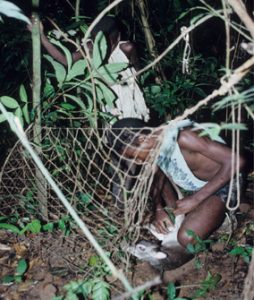
NOSS – The hunt for sustainability in African rainforests: bushmeat and hunter-gatherers
Andrew J. Noss, Daniel J. Ingram
Article first published online: NOV 2016 Conservation Biology newsletter, Africa Conservation Telegraph
ABSTRACT:
Unsustainable hunting threatens both biodiversity and local livelihoods. Three recent publications summarize collaborations of researchers representing an array of institutions working on hunting and wildlife conservation issues in African rainforests including CENAREST (Gabon), University of Buea (Cameroon), Imo State University (Nigeria), University of Pretoria (South Africa), CIFOR, TRAFFIC, UNEP-WCMC, University of Sussex, AWF, WCS, WWF, ZSL, FFI, Durrell Wildlife Conservation Trust, other African NGOs, as well as other European / United States / Japanese universities.
The OFFTAKE database was created in 2013 with the aim of synthesizing studies that quantify the harvest, consumption or transaction of wild species (www.offtake.org; Taylor et al. 2015). The database currently holds data for over 550 sites globally, spanning over four decades of research, providing a resource for analyses at national and regional levels. In order to track changes in offtake, consumption or #### over time, a more systematically selected and regularly monitored set of sites would be desirable, spanning a range of current depletion levels and contextual socio-economic circumstances in both regions. Wild meat researchers and policymakers need to develop indicators that are robust and practical to collect for track wild meat use and measure sustainability in order to inform national and regional policy on wild meat hunting (e.g. Ingram et al. 2015). The OFFTAKE database relies on the generous contributions of hundreds of researchers that have contributed their data. If you have appropriate data that you would be willing to share with us, please get in touch: info@offtake.org.
Two other compilation efforts focus on hunter-gatherers in Congo basin forests. Although numerous alternative terms to “Pygmy” have been used to refer the rainforest hunter-gatherers of the Congo Basin, none have been agreed upon by academics or the people themselves to replace it. Some academics and Central African government officers feel the term Pygmy is derogatory or does not adequately represent the people, but the term Pygmy sensu lato, to refer to all hunter-gatherer groups in Central Africa, is widely used by a broad group of people in Europe, Japan, the United States and Africa. Moreover, international and local NGOs use the term in their titles or literature. Pygmy groups consider themselves, and are judged by their farming neighbors, as the aboriginal people of the Central African forests. They identify closely with the forest, and depend to varying degrees on hunting and gathering wild products from the rainforest ecosystem. Recent legislation in some countries has recognized the rights of “autochthones” (indigenous or first peoples). However, despite such provisions under law, in all countries where Pygmies are found, they are increasingly marginalized, and threatened by disease, displacement, forced sedentarization, and deforestation (Olivero et al. 2016).
The first effort compared data on game harvests from 60 Pygmy and non-Pygmy settlements in the Congo Basin forests, finding that the non-Pygmy population may be responsible for 27 times more animals harvested than the Pygmy population. Non-Pygmy hunters take a wider range of species, twice as many animals per square kilometer, a larger proportion of game with low population growth rates, and sell more bushmeat for profit. The intense competition that may arise from the more widespread commercial hunting by non-Pygmies is a far more important constraint and source of conflict than are protected areas (which may restrict use rights) for Pygmies (Fa et al 2016).
The second effort compiled locational data and population sizes for 654 Pygmy camps and settlements across five countries (Olivero et al. 2016). These data were used to develop spatial distribution models based on the favorability function, which distinguish areas with favorable environmental conditions from those less suitable for Pygmy presence. Highly favorable areas were significantly explained by presence of tropical forests, and by lower human pressure variables. For documented Pygmy settlements, the relationship between observed population sizes and predicted favorability values was used to estimate the total Pygmy population of around 920,000 Pygmies (over 60% in DRC) within favorable forest areas in Central Africa. Fragmentation of the existing Pygmy populations, alongside pressure from extractive industries and sometimes conflict with conservation areas, endanger their future. There is an urgent need to inform policies that can mitigate future external threats to these indigenous peoples’ culture and lifestyles.
Read the full publication at Conservation Biology newsletter, Africa Conservation Telegraph